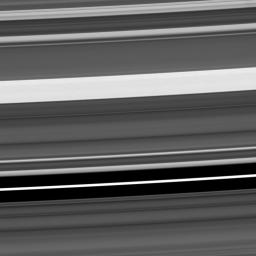
|
Many Faces of the C Ring
- Click the image above for a larger view
- Full-Res JPEG (1014 x 1014) (73.3 kB)
- Full-Res TIFF (1014 x 1014) (1.0 MB)
Caption:
The range of features to be found in Saturn's C ring is seen in this Cassini image.
Near the bottom of the frame is a narrow eccentric ringlet lying in a gap that researchers suspect may contain one or more very small moons. Farther up, the bright feature is one of the C ring's "plateaus." These bright features in the C ring are much denser than the surrounding material, and their origin is also being studied.
The image was taken in visible light with the Cassini spacecraft narrow-angle camera on Nov. 9, 2008 at a distance of approximately 339,000 kilometers (211,000 miles) from Saturn and at a Sun-Saturn-spacecraft, or phase, angle of 101 degrees. Image scale is 2 kilometers (1 mile) per pixel.
Background Info:
The Cassini-Huygens mission is a cooperative project of NASA, the European Space Agency and the Italian Space Agency. The Jet Propulsion Laboratory, a division of the California Institute of Technology in Pasadena, manages the mission for NASA's Science Mission Directorate, Washington, D.C. The Cassini orbiter and its two onboard cameras were designed, developed and assembled at JPL. The imaging operations center is based at the Space Science Institute in Boulder, Colo.
For more information about the Cassini-Huygens mission visit http://saturn.jpl.nasa.gov/ . The Cassini imaging team homepage is at http://ciclops.org .
Cataloging Keywords:
| Name | Value | Additional Values |
|---|---|---|
| Target | Saturn Rings | C Ring, Saturn |
| System | Saturn | |
| Target Type | Ring | Planet, Satellite |
| Mission | Cassini-Huygens | |
| Instrument Host | Cassini Orbiter | |
| Host Type | Orbiter | |
| Instrument | Imaging Science Subsystem (ISS) | |
| Detector | Narrow Angle Camera | |
| Extra Keywords | Gap, Grayscale, Visual | |
| Acquisition Date | ||
| Release Date | 2008-12-18 | |
| Date in Caption | 2008-11-09 | |
| Image Credit | NASA/JPL/Space Science Institute | |
| Source | photojournal.jpl.nasa.gov/catalog/PIA10537 | |
| Identifier | PIA10537 | |
